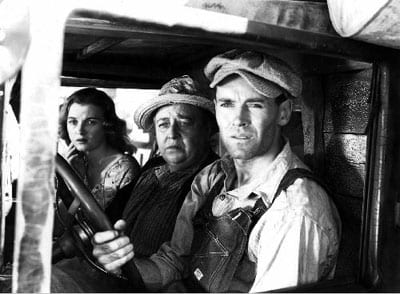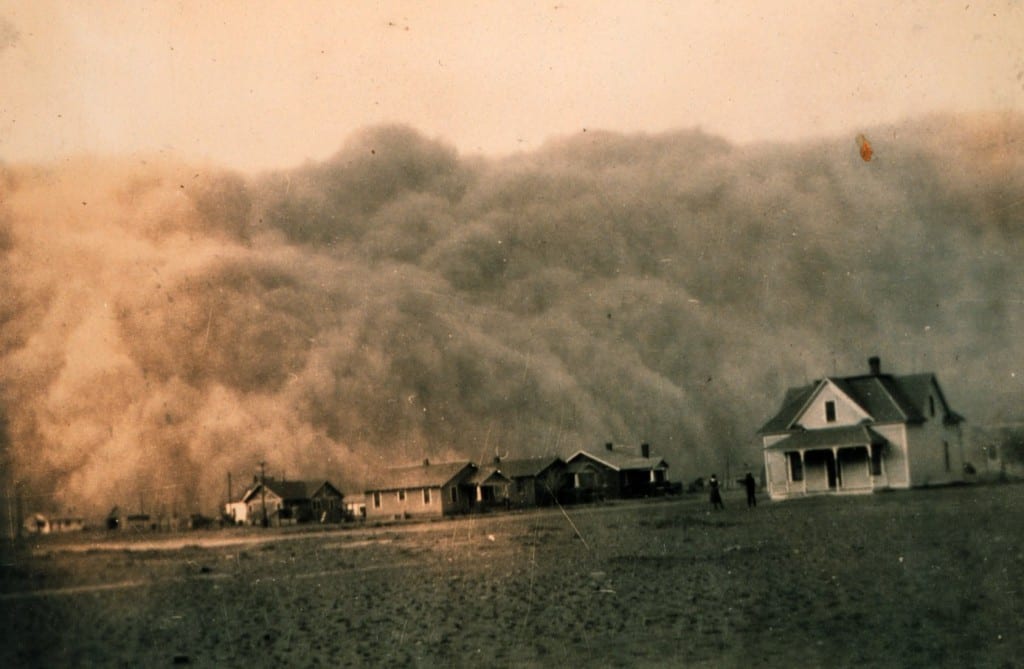What caused the Dust Bowl?
Much of the planet may soon become a gigantic dust bowl plunging not millions but billions of humans and nonhumans into an abyss of unprecedented misery.
The answer:
Ignorance • Everybody for himself. • Greed. • An ineffectual, slow-to-respond government. • UNCHECKED PREDATORY CAPITALISM, And finally, nature itself..
But nature should not be blamed, cannot be blamed. She gave humanity plenty of time and warnings to realize what was coming. ..
Editor’s Note: The enormous suffering and ecological devastation of the Dust Bowl, one of the greatest ecological catastrophes in history, with its epicenter in the Southern Great Plains, has apparently not registered enough among many Americans, especially those in the Southwest, if we consider that the region continues to be a rampart of hard-core libertarianism, Republicanism, and hostility to government, a tribute to the power of nonstop business propaganda to deny even the most self-evident truths. What can America and the world expect now that through global warming we have unleashed a far more catastrophic ecological nightmare?—PG
What caused the Dust Bowl?
When pioneers headed west in the late 19th century, many couldn’t resist the lure of the tall grassy land in the semiarid midwestern and southern plains of the United States. They settled there to farm. They were prosperous in the decades that followed, but when the 1930s rolled in, so did strong winds, drought and clouds of dust that plagued nearly 75 percent of the United States between 1931 and 1939 [source: PBS]. The era became known as the legendary Dust Bowl.
The Dust Bowl brought ecological, economical and human misery to America during a time when it was already suffering under the Great Depression. While the economic decline caused by the Great Depression played a role, it was hardly the only guilty party. What circumstances conspired to cause the Dust Bowl? Economic depression coupled with extended drought, unusually high temperatures, poor agricultural practices and the resulting wind erosion all contributed to making the Dust Bowl.
The seeds of the Dust Bowl may have been sowed during the early 1920s. A post-World War I recession led farmers to try new mechanized farming techniques as a way to increase profits. Many bought plows and other farming equipment, and between 1925 and 1930 more than 5 million acres of previously unfarmed land was plowed [source: CSA]. With the help of mechanized farming, farmers produced record crops during the 1931 season. However, overproduction of wheat coupled with the Great Depression led to severely reduced market prices. The wheat market was flooded, and people were too poor to buy. Farmers were unable to earn back their production costs and expanded their fields in an effort to turn a profit — they covered the prairie with wheat in place of the natural drought-resistant grasses and left any unused fields bare.
But plow-based farming in this region cultivated an unexpected yield: the loss of fertile topsoil that literally blew away in the winds, leaving the land vulnerable to drought and inhospitable for growing crops. In a brutal twist of fate, the rains stopped. By 1932, 14 dust storms, known as black blizzards were reported, and in just one year, the number increased to nearly 40.
Millions of people fled the region. The government enacted aid programs to help, but it wasn’t until 1939 when the rain returned that relief came. Next we’ll explore the migration and the measures taken to save the heartland.

A father and son are slowed by a dust storm in their walk toward a shack. Arthur Rothstein/Resettlement Administration/Time Life Pictures/Getty Images
Effects of the Dust Bowl
When the drought hit the Great Plains, roughly one-third of the farmers left their homes and headed to the mild climate of California in search of migrant work. Known as the Okies — the nickname referred to any poor migrant from the American Southwest since only about 20 percent were from Oklahoma — they left behind the parched lands and economic despair. Many were used to financial stability and home amenities such as indoor plumbing, but had become financially indebted after purchasing mechanized farming equipment and suffering crop failures. They faced foreclosure on home and farm.
California didn’t welcome the influx of Okies. Since the number of migrant workers outnumbered the available jobs, tensions grew between Californians and laborers, and public health concerns rose as California’s infrastructure became overtaxed.

Literature reflected the era’s misery. Steinbeck’s The Grapes of Wrath was almost universally declared an instant masterpiece after its release in 1940. But post war prosperity soon made the story about the struggles of Depression era farmers seem dated. The current economic crisis, however, has given the film new life and a new generation of viewers thanks to recent stage productions. Youtube is now loaded with clips from the film. (Charles Wiebe, at moviefanfare.com)
In 1933, President Franklin D. Roosevelt enacted the first of several mortgage and farming relief acts under the New Deal aimed to reduce foreclosures and keep farms afloat during the drought. But by the end of 1934, roughly 35 million acres of farmland were ruined, and the topsoil covering 100 million acres had blown away [source: PBS].
Under the Taylor Grazing Act of 1934, the government reserved 140 million acres as protected federal lands. Grazing and planting would be monitored to encourage land rehabilitation and conservation. Additionally, in the early 1930s, the government launched the Civil Conservation Corps (CCC), one of the most successful New Deal programs. Three-million young men volunteered for forestry and conservation work for the CCC. They were called Roosevelt’s “Forest Army,” and they planted trees, dug ditches and built reservoirs — work that would contribute to flood control, water conservation and prevent further soil erosion.
Additionally, between 1933 and 1935 many more programs and agencies were introduced specifically to help people affected by the Dust Bowl, including efforts like the Emergency Relief Appropriation Act, the Resettlement Administration, the Farm Security Administration, the Land Utilization Program and the Drought Relief Service.
The Works Progress Administration (WPA), a program started under the Emergency Relief Appropriation Act, is one of the best-known New Deal programs. The WPA was a work relief program that employed more than 8.5 million people to build roads, bridges, airports, public parks and buildings [source: PBS].
It took millions of tons of dirt and debris blowing from the Plains all the way into Washington D.C., known as “Black Sunday,” to move Congress to pass the Soil Conservation Act and establish the Soil Conservation Service (SCS) under the Department of Agriculture.
The SCS (now the Natural Resources Conservation Service) promoted healthy soil management and farming practices, and paid farmers to put such practices to work on their farms. The legacy of the Service’s practices such as irrigation, crop diversity and no-till farming continue in the Plains today.
The 1930s Dust Bowl didn’t inoculate the United States from another such ecological disaster, though. About 90 percent of the 450 million hectares of arid land in North America suffers from moderate to severe desertification [source: Center for International Earth Science Information Network]. Sustainable agriculture and soil conservation practices could help avoid another dust bowl, but experts aren’t sure that such measures will be enough if extended and severe drought revisits the Great Plains.
No-till Farming
Tilling is a method of turning over the top layer of soil to remove weeds and add fertilizers and pesticides. But tilling also allows carbon dioxide, an important soil nutrient, to escape from the topsoil. No-till is a sustainable farming method that helps nutrients stay put. Organic matter, such as crop residue, remains at the surface — healthy topsoil is fertile and decreases water runoff and erosion.




